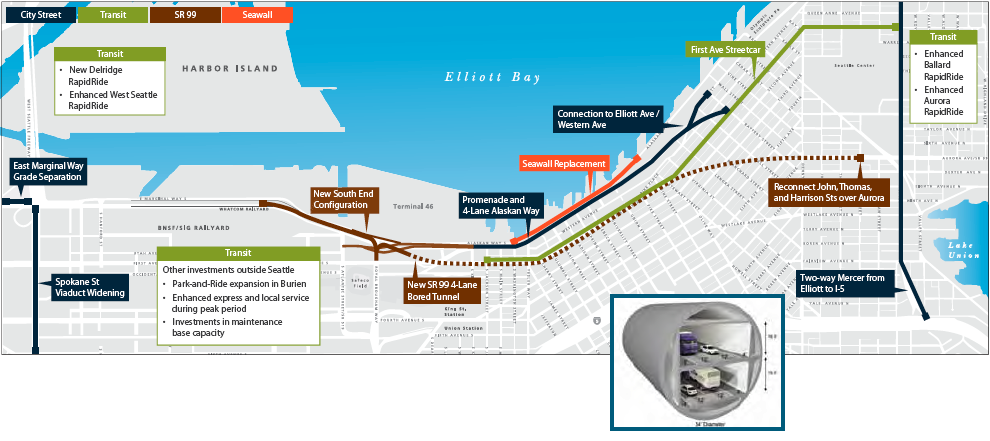Seattle's tunnel for viaduct replacement approved
Apr 2009
- The planned replacement of Seattle's aging and earthquake-damaged Alaskan Way Viaduct in a deep, bored tunnel has been approved by the Washington State Legislature. A Senate vote on Friday 24 April agreed 39-9 with a 53-43 vote on the previous Wednesday (22 April) in the House of Representatives to replace the old double-deck elevated highway with a double-deck single-tube large diameter bored tunnel.
- In a statement after the Senate vote, State Governor Chris Gregoire she will sign the Alaskan Way Viaduct bill into law, saying the tunnel project "will create jobs, help us emerge from this recession stronger, and prepare our State for a 21st economy."
- After years of study and debate, the plan commits $2.4 billion in State money and an added $400 million in toll revenue to the project of building the new tunnel and demolishing the 55-year-old concrete viaduct The waterfront freeway is used by some 100,000 vehicles per day.
- The projects bill caps State funding for the tunnel at $2.4 billion, subject to reconsideration after an expert review panel updates the cost estimate by January 1, 2010. It also states that "no more than $400 million of [any] additional costs shall be financed with toll revenue. Any costs in excess of ($2.8 billion) shall be borne by property owners in the Seattle area who benefit from replacement of the existing viaduct with the deep-bore tunnel." The City has committed to raising $930 million for its share of an overall project that includes a new Elliott Bay sea wall, plus a new promenade and other surface improvements, and Seattle Mayor Greg Nickels said the City might use a downtown property tax, along with other taxes, fees and grants, to cover those costs.
- As proposed, the tunnel is 54ft in diameter, with two traffic lanes on each of two decks and run from a south portal near the Mariners' and Seahawks' stadiums to a north portal on Aurora Avenue North, three blocks east of the Seattle Center. The details of the project will be discussed as part of a one day tunneling symposium in Seattle organized by the UCA of SME on Monday 4 May and by an industry outreach forum organized by the Washington Department of Transportation for Tuesday afternoon 5 May. Topics for discussion will include the reasons for selecting a single large diameter bored tunnel for the project instead of two smaller-diameter, single-deck tunnels, and the alignment alternatives being studied.
-
Washington State Department of Transportation
UCA of SME symposium 4 May, 2009 -TunnelTalk
Industry discussion forum 5 May 2009
Bored tunnel for downtown Seattle
Jan 2009
Paula Wallis, Reporter
- After years of indecision and political infighting local, state and federal officials are finally speaking with one voice in calling for a tunnel under downtown Seattle to replace the aging Alaskan Way Viaduct.
-

Tunnel alignment
- In a joint news conference Tuesday January 13, 2009 Governor Chris Gregoire, Seattle Mayor Greg Nickels and King County Executive Ron Sims signed a letter recommending to the state Legislature that the Viaduct be replace with a bored tunnel.
- “Building a deep bored tunnel will support a strong economy today and in the future,” Gregoire said. “This is not a solution for tomorrow, it is a solution of the next 100 years.”
- The bored tunnel will be approximately two miles long and is currently planned as a stacked tube with two lanes in each direction. The alignment will run as deep as 160ft underground.
- Drivers will bypass the downtown by entering the tunnel near the sports stadiums in the south and connect to SR 99 north of the existing Battery Street Tunnel.
- Most notably, the alignment will run roughly under 1st Street east of the current viaduct allowing it to remain open to traffic during tunnel construction. This will contain mitigation costs associated with keeping a city open and traffic moving during construction. A necessity that experts say played a major role in pushing the cost of Boston’s ‘Big Dig’ to stratospheric levels.
-
Computer simulation of proposed tunnel
- The estimated cost of the project is $4.24 billion with $2.8 billion coming from state gas taxes and federal bridge funds for construction of the tunnel and a four-lane surface street when the existing viaduct comes down.
- “We settled on a bored tunnel because it solves an array of problems and because we’ve learned that the technology continues to improve,” said Gregoire. “We know we can do it, and do it at a reasonable cost. This is a viable solution, and I’m very proud of it.”
- The city of Seattle has pledged up to $930 million to replace the central seawall and construct a waterfront promenade, relocate utilities, build a streetcar on First Avenue, and improve east-west streets.
- The county will seek new motor vehicle excise tax authorization from the legislature to fund over $190 million in transit capital and $15 million annually in operating expenses.
- Port CEO Tay Yoshitani will ask the Port Commission to consider a $300 million investment in the replacement of the south mile of the viaduct and a new east-west connection to the container terminals.
- “There are pivotal moments when great cities make history,” said Greg Nickels, Mayor of Seattle. “Today, we reclaim our destiny as a true waterfront city—tearing down an elevated highway and re-connecting Seattle to Elliott Bay.”
- Construction is scheduled to begin in 2011 and be open to drivers in 2015. The project is expected to create 10,000 jobs in a ten-year span.
